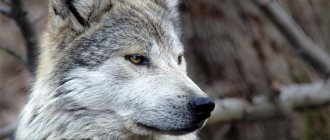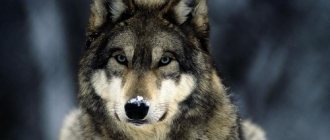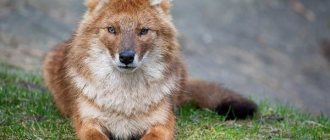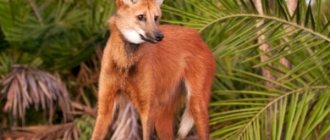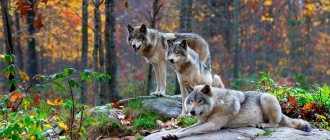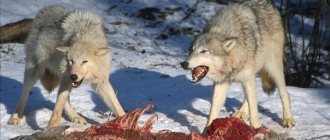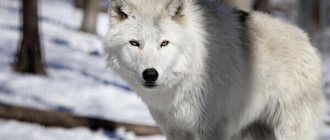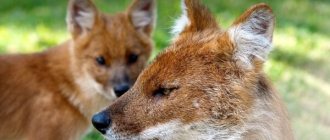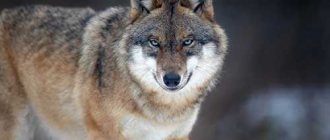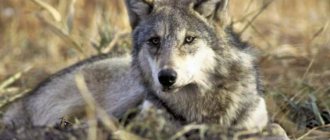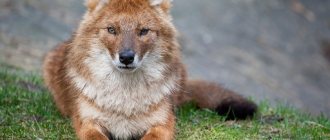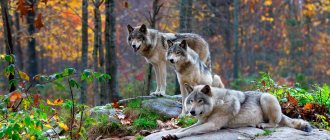This is a subspecies of the familiar gray wolf. It lives in northern Greenland, the Arctic regions of Canada, and Alaska. In a harsh climate with snow drifts, icy winds, bitter frosts and permafrost, the animal lives for hundreds of years. The polar wolf has completely preserved its natural habitat, unlike its gray, red and other brothers. This fact is explained by the rare appearance of humans on these harsh lands.
Polar wolf: description
This is a large, powerful animal - the height of males at the withers reaches one hundred centimeters, the body length is one hundred and eighty centimeters, and the weight is around ninety kilograms. Females are on average 15% smaller. The Arctic polar wolf has thick light fur with a reddish tint, small erect ears, long legs, and a bushy tail.
For months this animal does not see sunlight. He got used to the polar night. In search of food, he can scour the snowy plain for a week. He easily eats ten kilograms of meat in one go. Not a trace remains of his prey. Even bones end up in the predator’s stomach, which it chews with forty-two powerful teeth. At the same time, he practically does not chew food, but swallows it in whole pieces.
Living conditions
The habitat of polar wolves is concentrated in the Arctic tundra, with the exception of ice areas. These representatives are also found in dark polar areas. The animals have adapted to the harsh conditions of the Arctic, which is why they are able to withstand low temperatures for a long time, often go hungry and do not have access to sunlight.
At the moment, these predatory animals inhabit the most barren areas of the earth. The temperature has not risen above 30 degrees Celsius since April, and the entire territory is exposed to strong and gusty winds. Life activity in the Arctic is supported by an extremely small number of mammals.
Life in a pack
It has long been known that the wolf is a social animal. He lives only in a pack. Typically, this is a family group of seven to twenty individuals. It is led by a male and a female. All the rest are cubs and grown-up young wolves who remained in the pack from previous litters. Sometimes a lone wolf may join the pack, but he strictly obeys the leaders.
Giving birth to puppies in a pack is the priority right of the female leader. The cubs of other females are destroyed immediately. The polar wolf of the tundra adheres to such harsh laws - it is difficult to feed a large number of mouths.
The survival of a pack depends on how large its hunting grounds are. That is why they fight to the death for their territory. This territory can be from fifty to one thousand five hundred square kilometers.
Enemies and threats
Polar wolves have suffered less from human persecution than other species. Thanks to living in areas little developed by humans, the tundra wolf, unlike its southern relatives, is not threatened by extermination by hunters or a decrease in the size of its habitat. However, the growing scientific and industrial interests of people in the Arctic are leading to closer contact.
Animals may be affected by any climate change. Unseasonal snowfalls can lead to a reduction in the number of hares and musk oxen, which are prey for white predators. The Arctic wolf is the only subspecies that is not yet threatened.
Polar wolves are graceful and strong animals. These individuals are among the largest wolves in the world. Polar wolves are adapted to survive in the harshest conditions - in the Far North.
Nutrition
The polar wolf is omnivorous. He eats everything he manages to catch, and those who are significantly weaker than him. In the summer, predators feed on birds, frogs and even beetles. They do not refuse berries, fruits and lichens. In winter, their diet contains more meat - deer, musk oxen.
The polar wolf is a born hunter. He stalks his prey skillfully, using changing riders and ambushes. Hunting is especially successful in the spring: when the snow crust melts a little, the deer falls through, and the predator quickly catches up with it.
A strong and healthy ungulate has nothing to fear from a wolf. Therefore, the flock tries to find old and sick animals or young and inexperienced fawns. Having attacked a herd, wolves strive to disperse it in order to drive away their future victim and quickly overwhelm it. In cases where the herd has time to regroup and surrounds its offspring in a tight ring, strong hooves and sharp horns will scare off the predators, and they will ingloriously leave the battlefield.
If the hunt is successful, then the leader starts the meal first; he eats the best pieces, and at this time the flock stomps around, waiting for their turn. If a polar wolf catches a small animal, it will eat it whole, including the skin. He needs to thoroughly satisfy his hunger, because only ten percent of his hunting trips are successful.
Hunting
Polar wolves are predators. According to the International Wolf Center, they hunt over an area of more than 1,000 square miles because prey is rare.
The largest animals they hunt are musk oxen and caribou. If the opportunity arises, the predator feeds on deer and other ungulates. Smaller prey includes snow geese, partridges, small rodents, arctic hares and other animals, as well as vegetation.
The polar wolf is rather very hardy than fast and strong. It is capable of dragging large prey over long distances.
Reproduction
Puberty occurs in females by three years, in males by two. Shortly before giving birth, the she-wolf prepares a hole. Since it is impossible to dig it in permafrost, the birth takes place in a cave, a crevice between rocks, or in an old lair. Pregnancy lasts from sixty to seventy-five days. There are no more than three puppies in a litter, although there have been cases where five and seven puppies were born, but this happens very rarely.
Newborns are born completely helpless and blind, weighing approximately four hundred grams. They stay in the den for a month, after which they begin to make their exits into the world. All this time the she-wolf feeds them milk. After a few months, she begins to feed the cubs with the food she has obtained.
The white polar wolf is a very good and caring parent. The whole flock takes care of the babies. When the she-wolf goes hunting, young wolves look after the babies. Even when there is very little food, all members of the flock try to feed the babies. Thus, a stable population size is maintained. In this case, the human influence is practically not felt - there are few people who want to hunt in the Arctic.
Population and species status
Photo: White polar wolf
The polar wolf population has remained unchanged since ancient times. This is due to the fact that since ancient times they have occupied northern territories, where hunting for them is complicated by climatic conditions. Arctic wolves can be hunted by the indigenous peoples of the north - their warm and soft fur is used for clothing and shelters. But the hunt is not widespread, since the wolf is a formidable predator that can both attack and quickly retreat.
The interests of the indigenous inhabitants of the North and wolves intersect only with domesticated reindeer. Domestic herds are easy prey for a pack of wolves. People protect herds of deer, and wolves are afraid of people, but sometimes they still meet. As a result, the wolves either die or flee. But polar wolves can pursue nomadic people along with their herds.
Polar wolves are kept in zoos. They have the same habits as gray wolves. Captive-born polar wolves treat people well, mistaking them for members of the pack. A person can even be perceived by wolves as a leader, so the wolves wag their tails in front of him and lay down their ears.
The polar wolf is a proud and beautiful animal. Thanks to the fact that it is adapted to survive in the harshest climatic conditions, it is inaccessible to poachers, and its numbers have not changed over the centuries.
Date of publication: 08/01/2019
Update date: 09.28.2019 at 11:27
Tags:
- Wolves
- Deuterostomes
- Bilaterally symmetrical
- Wild animals of Russia
- Animals of Alaska
- Animals of the Arctic belt
- Animals of Greenland
- Animals of Canada
- Animals of the forest-tundra
- Animals starting with the letter B
- Animals starting with the letter P
- Animals of Russia
- Animals of the North
- Animals of the Subarctic Zone
- Animals of the tundra
- Animals of the Temperate Zone of the Northern Hemisphere
- Animals
- Interesting animals of the world
- Laurasiotherium
- Unusual animals
- Dangerous animals of the world
- Placental
- Vertebrates
- Canids
- The largest animals in the world
- The fastest animals in the world
- The most beautiful animals
- The cutest animals in the world
- The most unusual animals in the world
- The most dangerous animals
- The most powerful animals in the world
- The most amazing animals
- Caniformes
- Predators
- Predatory
- Predatory animals
- Chordates
- Ghostostomes
- Quadrupeds
- Eukaryotes
- Eumetazoans
Start of independent life
Having reached puberty, young wolves leave the pack and try to create their own. They find an empty area and mark it. It is unknown what their life will be like next. If a free female appears on its territory, a new couple will be formed, which will eventually give birth to puppies. As a result, a new flock will appear. But there may be another outcome of the situation - the polar wolf, having been pushed around alone, joins another pack. However, in this case, he has no chance of becoming a leader - he will always remain in the background.
An intelligent and cunning predator - the polar wolf - tries not to meet a person. Their interests can only intersect on the reindeer, which the man carefully protects. But in any case, we cannot allow the wolf to become a sworn enemy of people, and they would completely exterminate it, as happened in Mexico, Japan, and Iceland.
Features of communication
Wolves communicate with each other through howls. For example, sometimes one predator howls to attract the attention of the entire pack, an entire pack of wolves may howl at the same time to send territorial messages to another pack, or one animal may start howling just because another is nearby.
Unlike their brothers, polar wolves are not afraid of people, mainly because there are very few populated areas in their habitats.
Eifel
Such representatives of the shrew family - small resorts (German: Sumpfspitzmaus) - live in the Eifel National Park. It was founded on the border with Belgium in 2004. More than 900 species of protected animals and plants are found here. There are 240 kilometers of hiking trails and more than 100 kilometers of cycling routes for visitors.
German national parks
Non-contact sensor Secret-3 with the ability to work in slider mode
A new sensor control mode has appeared - slider, i.e. control is performed by sliding your hand over the surface of the Secret-3 sensor.
The non-contact sensor Secret -3 is a Remote Button (RK) - an electronic product that controls various devices by approaching and removing a hand or finger from the sensor. A new sensor control mode has appeared - slider, i.e. control is performed by sliding your hand over the surface of the Secret-3 sensor.
At a distance of up to 1 centimeter from the sensor surface, reliable operation is maintained through any dielectric (plastic, glass, wood, etc.). Having a glove on your hand is not an obstacle to typing the code.
Lower Oder Valley
The Lower Oder Valley National Park (Nationalpark Unteres Odertal) was founded in Germany in 1995 on this border river in the Uckermark region. The park stretches along the Oder on a strip ranging from two to eight kilometers wide. Particularly famous here are the villages with numerous stork nests on the roofs. Water meadows serve as a resting place for migratory birds.
German national parks
Vocalization
Wolves can whine, squeal, bark, and howl. The famous wolf howl, which terrified travelers in ancient times, is both a collective greeting and a deterrent for neighbors. In order to create the illusion of a larger pack, wolves use polyphony! The wolf chorus can most often be heard in winter, when the animals organize a collective hunt for large ungulates. With a powerful, well-coordinated chorus, they inform the other flock that the feeding grounds are occupied.
Natural parks
For example, residents of Cologne, Düsseldorf or Bonn have a direct route to the neighboring Naturpark Bergisches Land. In the century before last, these places were even called “Prussian Siberia” - they were so wild and dense. Naturpark Siebengebirge is also located nearby. From Hamburg it’s a stone’s throw to the Lüneburg Heath (Naturpark Lüneburger Heide).
German national parks
About company
The research and production company was founded in St. Petersburg in 1996. Over the years of work in the field of research, development and production of professional electronic systems, the company has accumulated a wealth of experience, which allows it to produce equipment under its own brand, as well as develop and produce electronic systems according to customer specifications.
Equipment production is located in Russia, in St. Petersburg. The use of the best components allows us to ensure high quality of manufactured equipment. The products are certified and comply with Russian Federation State Standards. The quality control system is certified in accordance with the international standard ISO-9001-2008.
| Since 1996, the company has been developing and producing professional anti-theft security systems. The development concept is based on the analysis of real “intelligent” attempts to hack existing systems on the market using high-tech electronic means. | Research, development, productionSince 2006, one of the leading areas of the company has been individual product design for its customers; from research to production. The development concept is based on an analysis of the actual operating conditions of the ordered electronic systems. |
| Our products are: Miniature – reducing to zero any attempts to detect the system. Tightness – operation in any climatic conditions with humidity up to 100% and temperature range from -40°C to +85°C. Crypto security – providing complete protection against selection or hacking of the system control code. Functionality – satisfaction of any user wishes without loss of security functions of the system. | Cooperation with us means: Flexibility - discussing with the customer any changes in the technical specifications both at the research stage and at the final cycle - mass production. Profitability – planned production of products at a pre-agreed price with the possibility of price reduction. Reliability – quality guarantee, problem-free warranty return of products. Efficiency – the ability to quickly increase or reduce the volume of products. |
Jasmund National Park
On the Baltic island of Rügen is the Jasmund National Park, the smallest in Germany. Founded in 1990. The coastal Chalk cliffs, which served as a motif for the master of landscape painting Caspar David Friedrich, are especially limed. Part of the local Old Beech Forest is included in the UNESCO World Natural Heritage List.
German national parks
Low Saxon Watts
The Lower Saxony Wadden National Park (Nationalpark Niedersächsisches Wattenmeer) surrounds the East Frisian Islands. Seven of them are inhabited: Borkum, Juist, Norderney, Baltrum, Langeoog, Spiekeroog, Wangerooge. Wadden shallows play, in particular, an important role for the protection of seabirds and shorebirds that breed here or stop during seasonal migration.
